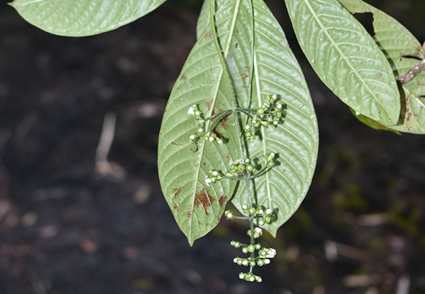Abstract
Psychotria pendens from the lowland ultramafic forest of Mt. Victoria, Palawan Island, Philippines is herein described as a new species of Rubiaceae. The new species is morphologically similar to P. rubiginosa (Gitingensis species group) by having monochotomous inflorescence and oblanceolate to oblong-elliptic leaves but is distinguished by its large, leaf-like, valvate stipules with biattenuate to biacuminate tips, pendent inflorescence, glabrous abaxial leaf surface, narrowly triangular bracts, and glabrous calyx. Molecular analysis revealed that this newly discovered species belongs to the Pacific Psychotria clade, and is allied to the Philippine species P. luzoniensis and Hawaiian species P. mariniana. The species is assessed as Critically Endangered (CR) based on the IUCN Red List categories and criteria.
References
- Alejandro, G.J. (2007) The Current Status of the Philippine Rubiaceae. Philippine Journal of Systematic Biology 1: 1. https://doi.org/10.3860/pjsb.v1i1.908
- Andersson, L. (2002) Relationships and generic circumscription in the Psychotria complex (Rubiaceae, Psychotrieae). Systematics and Geography of Plants 72: 167–202.
- Hamilton, C.W. (1989) A revision of Mesoamerican Psychotria subgenus Psychotria (Rubiaceae). Annals of Missouri Botanical Garden 76: 67–111; 386–429; 886–916. https://doi.org/10.2307/2399652
- IUCN Standards and Petitions Committee (2024) Guidelines for Using the IUCN Red List Categories and Criteria. Version 16. Prepared by the Standards and Petitions Committee. Available from: https://www.iucnredlist.org/resources/redlistguidelines (accessed 4 May 2024)
- Katoh, K. & Standley, D.M. (2013) MAFFT multiple sequence alignment software version 7: improvements in performance and usability. Molecular Biology and Evolution 30 (4): 772–780. https://doi.org/10.1093/molbev/mst010
- Mallari, N., Masigan, J.P., Uy, Q.A., Bautista, M.A.C, Abdao, D.R., Edaño, JW., Andaya, K.J.,Coroza, O., Felismino-Inovejas, R.A., Darapiza, D.G., Jasmin, C.J., Empillo, L., Javier, A.R., Batistin, R., Yayen, V., Bibar, J.L., Tablazon, D. & Jimenez, J.P. (2022) Green assessment framework: a biodiversity and ecosystem-based analysis for post-disaster needs assessment, green reconstruction, and resilience planning. Abridged Report. Center for Conservation Innovation PH, Inc. Supported by the USAID, 29 pp.
- Murray, M.G. & Thompson, W.F. (1980) Rapid isolation of high molecular weight plant DNA. Nucleic Acids Research 8 (19): 4321–4325. https://doi.org/10.1093/nar/8.19.4321
- Nepokroeff, M., Bremer, B. & Systma, K.J. (1999) Reorganization of the genus Psychotria and tribe Psychotrieae (Rubiaceae) inferred from ITS and rbcL sequence data. Systematic Botany 24: 5–27. https://doi.org/10.2307/2419383
- Pelser, P.B., Barcelona, J.F. & Nickrent, D.L. (Eds.) (2011 onwards) Co’s Digital Flora of the Philippines. Available from: https://www.philippineplants.org/ (accessed 17 December 2022)
- Piesschaert, E. (2001) Carpology and pollen morphology of the Psychotrieae (Rubiaceae-Rubioideae). Towards a new tribal and generic delimitation. Katholieke Universiteit Leuven, Leuven, Belgium.
- Piesschaert, E., Robbrecht, E. & Smets, E. (2001) Patterns in pyrenes: the systematic significance of pyrene morphology in Chassalia (Rubiaceae-Psychotrieae) and related genera. Flora 196: 121–131. https://doi.org/10.1016/S0367-2530(17)30027-0
- Razafimandimbison, S.G., Taylor, C.M., Wikström, N., Pailler, T., Khodabandeh, A. & Bremer,B. (2014) Phylogeny and generic limits in the sister tribes Psychotrieae and Palicoureeae (Rubiaceae): Evolution of schizocarps in Psychotria and origins of bacterial leaf nodules of the Malagasy species. American Journal of Botany 107 (1): 1102–1126. https://doi.org/10.3732/ajb.1400076
- Sohmer, S.H. & Davis, A.P. (2007) The genus Psychotria (Rubiaceae) in the Philippine Archipelago. SIDA, Botanical Miscellany 27: 1–247.
- Tamayo, M.N., Bustamante, R.A.A. & Fritsch, P.W. (2021) Vaccinium exiguum (Ericaceae, Vaccinieae), a new species from the ultramafic summit of Mt. Victoria, Palawan Island, Philippines. PhytoKeys 179: 145–154. https://doi.org/10.3897/phytokeys.179.68323
- Taylor, C.M., Razafimandimbison, S.G., Barrabé, L., Jardim, J.G. & Barbosa, M.R.V. (2017) Eumachia expanded, a pantropical genus distinct from Psychotria (Rubiaceae, Palicoureeae). Candollea 72 (2): 289–318. https://doi.org/10.15553/c2017v722a6
- Turland, N.J., Wiersema, J.H., Barrie, F.R., Greuter, W., Hawksworth, D.L., Herendeen, P.S., Knapp, S., Kusber, W.-H., Li, D.-Z., Marhold, K., May, T.W., McNeill, J., Monro, A.M., Prado, J., Price, M.J. & Smith, G.F. (Eds.) (2018) International Code of Nomenclature for algae, fungi, and plants (Shenzhen Code) adopted by the Nineteenth International Botanical Congress Shenzhen, China, July 2017. Regnum Vegetabile 159. https://doi.org/10.12705/Code.2018
- Trifinopoulos, J., Nguyen, L.T., von Haeseler, A. & Minh, B.Q. (2016) W-IQ-TREE: a fast online phylogenetic tool for maximum likelihood analysis. Nucleic Acids Research 44 (W1): W232–W235. https://doi.org/10.1093/nar/gkw256


